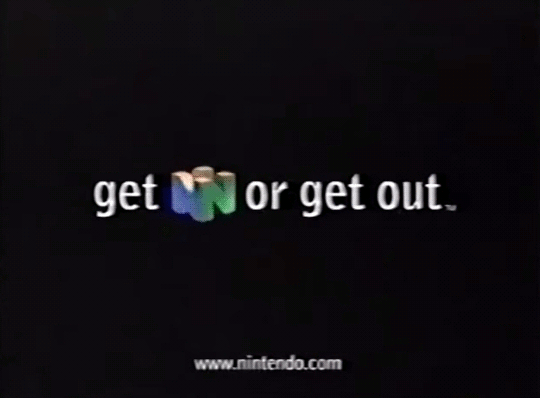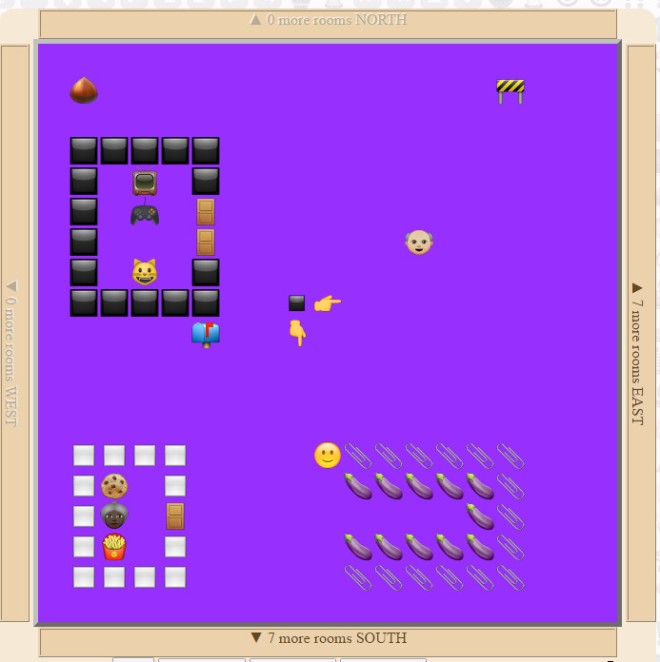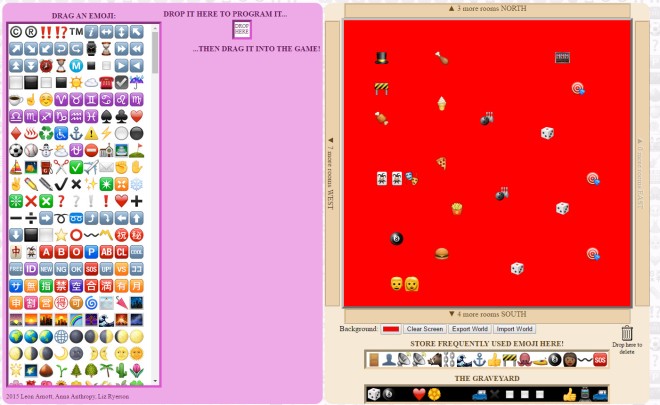
Nintendo’s infamous N64 slogan, which I adapted to discuss Chris Crawford’s game design concept of topic vs. content.
When it comes to advertising, I have always been strangely fascinated by the aggressive slogans used by game companies to market their products. These catchy phrases are designed to embed themselves into a person’s consciousness, becoming readymade mantras that every loyal follower of Nintendo, Sony, Sega or Microsoft must repeat over and over again. These slogans also communicate the guiding ideologies of these corporations, which often want their consumers to feel like insiders who speak a secret language that the rest of the world doesn’t understand.
Some game designers have embraced this ideology wholesale, viewing game design as a secret and elusive art with its own set of exclusive codes and strategies. Others, however, have been challenging this point of view, viewing game design in a much more critical, holistic, and inclusive light. With that in mind, I’ll be analyzing two game design concepts each from Chris Crawford and Mary Flanagan, contrasting their approaches, and how their concepts apply to Metatopia, the game Matt Bellefleur, Natalie Drumonde, and I made using anna anthropy’s Emotica Online. I’ll also start the discussion of each concept by adapting a slogan from videogame advertising or popular culture.
Chris Crawford — Get Content or Get Out!
In advertising the N64, Nintendo used the slogan “Get N or Get Out” as part of an aggressive campaign intended to communicate that not only had the system arrived (after multiple delays), but to declare that Nintendo customers were part of an exclusive elite, to which other game consumers need not apply. To me, Chris Crawford takes a similar approach when discussing topic vs. content in the “Common Mistakes” chapter of Chris Crawford on game design. For Crawford, content is king, and he shows derision for those who decide to lead with what their game is about rather than the problem they are trying to solve. He writes:
A young game designer once told with obvious pride that he was working on a “King Arthur” game. I wasn’t cruel enough to point out that he had already blundered from the get-go by thinking of it as a “King Arthur” game. But the fact is, the topic of a game has little to do with the core design problems.
For Crawford, a game designer should start with the specific interactions they want the player to have in the game. Only when you have decided if your game will require fast reflexes, trial and error, or intuition, can you decide the topic of the game (e.g. science fiction, first-person, or King Arthur). He doubles down on this point of view, writing: “if the topic really is the initiating concept in your thinking, then you simply don’t understand game design well enough to do a good job.”
I disagree with this completely. Crawford insists throughout the “Common Mistakes” chapter that there is a single way to do game design, and that all other methods are illegitimate. I do not think that leading with the topic first is a bad idea, and in fact, starting with your topic can help you better decide what game design tools you want to use and what interactions you want the game to have. I also don’t see topic vs. content being a real dichotomy, as they are not mutually exclusive and both are needed in designing a game.
In developing Metatopia, Matt, Natalie, and I started with what we wanted it to be about. We were very democratic in our process, ensuing each person’s ideas could be incorporated. Matt wanted the game to be about identity and characters treating you differently depending on how you appeared. Natalie wanted to have an educational and environmentally-conscious game. I wanted a game that was irreverent and focused on exploration and discovery.

The starting screen of Metatopia.
It was after we thought about these topics and how we would bring them together that we then thought about the specific interactions in the game. Matt wanted randomization and player identity change. Natalie wanted there to be strong environmental and environmental messaging delivered by characters. I wanted to have something that was easy to pick up and play as I’ve become increasingly uncomfortable with games that demand significant affective labour.
This is what led us to settle on Emotica Online as our game design tool, and to make a game that had a series of different environments and mini-narratives. We brought the topic and the content together, and I believe made a strong game, even if we lead with our topics before deciding on the game’s interactions.
Chris Crawford — Live In Your World. Edit In Ours.
The big slogan for the Playstation 2 was “Live in your world. Plays in ours.” The idea is that you have a normal, everyday, and possibly less thrilling corporeal existence. However, the world of the Playstation 2 is one of play and possibility. Crawford has a similar philosophy about game design toolsets: tools allows you to create, but they can also constrain you to another designer’s way of thinking. For Crawford, having cost-effective tools is desirable but he also thinks it shortcuts creative thinking. You’ll be editing in someone else’s world rather than your own. He singles out the level editor that ships with some games as his evidence. Level editors have made it easier than ever to make good levels thus people are focusing more on level design to creating more interesting game mechanics. He writes:
A truly fine tool is like a freeway: It gets you there especially quickly. Of course, like a freeway, a fine tool attracts a great many users, all of whom end up going to the same place, and if you take the freeway, you end up at a crowded beach.
His problem with level editors is that they are fine tools that always lead you to the same place. In this way of thinking, you are following the logic of the designers who included the level editor of the game rather than searching out the great peaks of good game design. Once again, I have to disagree. Simple tools are absolutely necessary for creativity.
I am sure Crawford would be contemptuous of Emotica Online as a design toolset, as it is very simple to use and furthermore fuses the level editor with the game itself. In Emotica Online, you are constantly aware of the toolset, and can instantly play around with the gameworld someone has designed. Furthermore, the game’s “programming” is very simple: you drag and drop emoji (the building blocks of the game) and define it as an item (which can be picked up), a player (which can be moved with the arrow keys), or a solid (a block that cannot be moved). We can also program simple transformations and animations. In contrast with what Crawford argues these constraints were good for our creative output and did not hinder it.

In Emotica Online, the game and the level editor are one and the same. There is no separation while playing.
Mary Flanagan—With Great Play Comes Great Responsibility
For this slogan, I had to look outside of videogames for a slogan that fit Flanagan’s concept of responsibility in creativity and play. The line “With great power comes great responsibility” is from the Spider-Man comic, arguing that power confers on those who have it (whether they are creative powers or web-slinging) an obligation to use it wisely and responsibly. Flanagan has a similar argument for the creative process:
As game design matures, and as games themselves become more ubiquitous and more meaningful to culture, there is a growing need for designers to approach the creative process with increased awareness and responsibility to be inclusive, fair, and cater to a variety of play styles.
I agree with this completely. Often I find that games and game design are marketed to a select “elite” who are the ones conferred with the power and the ability to create. This is simply not the case. Tools like Twine, Game Maker, and Scratch, have opened up a plethora of creativity. Not only that, they have ensured that people are able to tell stories outside the “mainstream” of current games, focusing on topics like race, poverty, and systemic injustice. As Flanagan writes: “Perhaps even more than these “tools,” these games are simultaneously systems of information, cultural products, and manifestations of cultural practice.”
One reason I like Emotica Online so much is that it simplifies the process of games and game design. Metatopia is very easy to play and edit. Matt, Natalie, and I were also conscious of the messages we embedded in Metatopia. We had the player character start off as the cat emoji as it is gender-neutral and a fairly friendly starting option. I wouldn’t say that Metatopia is completely barrier-free as it requires a computer and access to an Internet connection. However, I do think our game lowers the barrier of entry to play.
Mary Flanagan—Now You’re Playing With Critical Power!
Nintendo used the slogan “Now you’re playing with power” while advertising the Nintendo Entertainment System (NES) in the late ‘80s. The slogan also lent its name to Nintendo Power magazine. I adapt it here to talk about Flanagan’s Critical Play game design model. This model is supposed to embed specific values and critical play within the game design process. She contrasts this with the traditional model of game design, which sets up systems and rules, and iterates without considering diverse play styles and approaches.
We definitely embedded our particular values in Metatopia, using specific stories and environments as sites of criticism. While on the surface, Toilet Town seems to exist for the purpose of a joke, we created a storyline where Toilet Town is implicated in high consumption and environmental degradation. Most of Metatopia’s resources are being used by Toilet Town and another city called Terminalia. Frog Town also exists to critique the loud, insular male gamers who are distinguished by their misogyny, racism, and continued harassment of feminist game critics and game makers. This group has chosen the frog emoji as its most significant symbol, so we used that in our parody.
I also made a Game Theorist’s Play Area, that pokes fun at the assumptions of certain game theorists about play and pedagogy and to further the critique of self-identified “gamers.” From the standpoint of being made from emoji, Metatopia is mostly fun and irreverent, but we also wanted to encode our values and principles.
Overall, I would say that Flanagan’s methodology of critical play exerted a substantial influence on our game design practice. Using Emotica Online and designing a game that includes our personal values made Metatopia something fun and enjoyable, that is also a substantial exercise in critical making.

Metatopia’s wasteful and much derided Toilet Town.